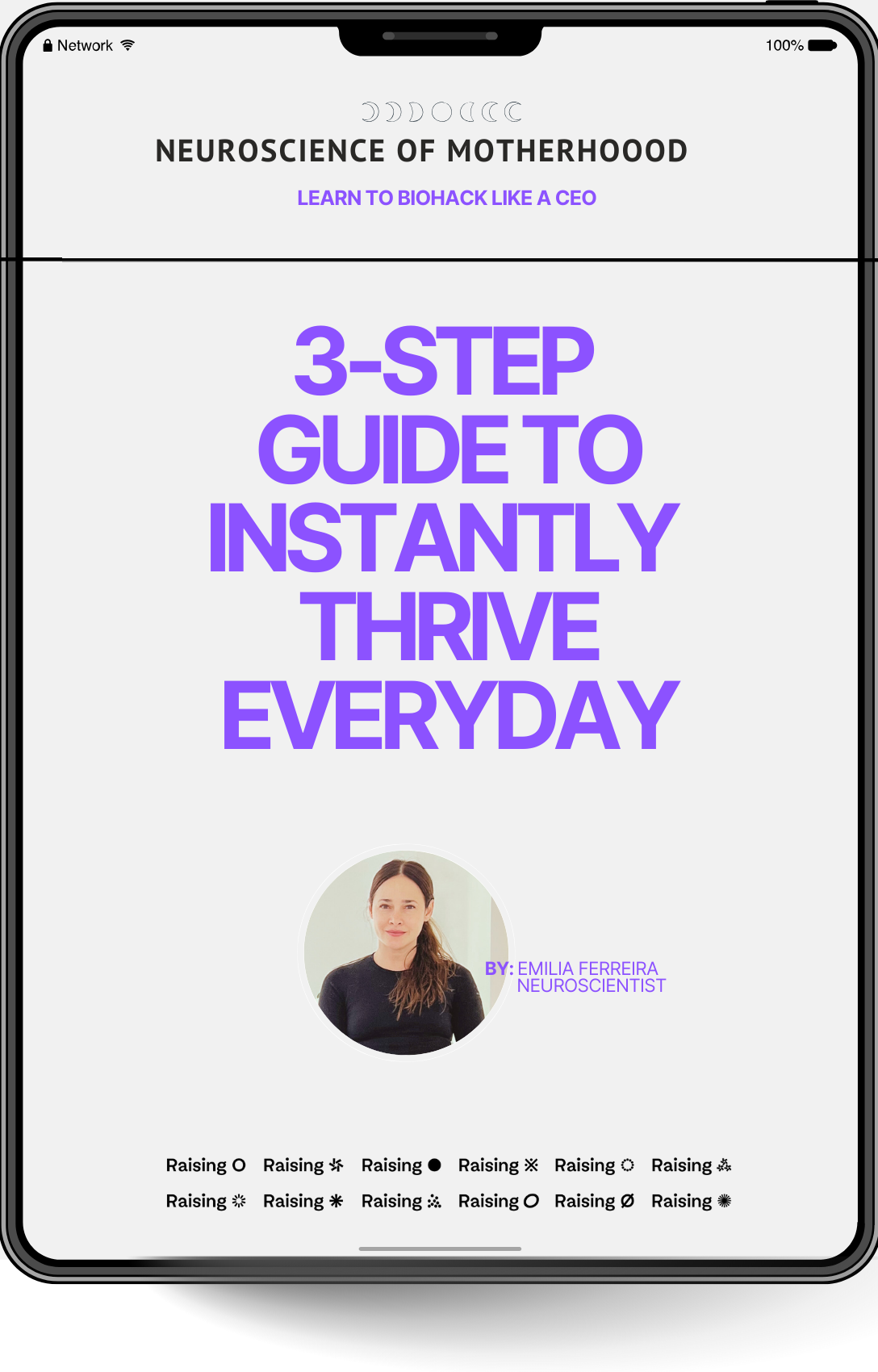Smiley Blue Welcomes Emilia Ferreira
We believe the most powerful stories come from those who live them. Today, we are honoured to welcome Emilia Ferreira—neuroscientist, motherhood futurist, and pattern disruptor—who invites us into an exploration of grief that is both deeply scientific and spiritual.
With her blend of curiosity and heartfelt honesty, Emilia shows us how love shapes the brain, how loss rewires it, and how we can carry those we’ve loved in ways that transcend their physical absence. In her work, Emilia offers a deeper understanding of how our minds, bodies, and hearts adapt to the mysteries of love and loss.
Get Emilia’s 3 Step Guide To Doing More With Less Using Biohacking With An Easy To Follow Blueprint.
👉 https://gift.raisingona.com/smileyblueThe Brain’s Battle Between Memory and Reality
Loved ones are deeply wired into our brains, and when they’re gone, it requires a process of rewiring. This is why it hurts so much to know that someone you love is no longer in their physical body. The brain strives to cope with this loss, working to reconcile the deeply ingrained bonds with the harsh reality of their absence.
Living with the Remnants of Care
Following the passing of my mother, I often woke up in the middle of the night, thinking it was time to give her medication, adjust her position to prevent bedsores, or check if she was in pain or still breathing. These sudden awakenings were accompanied by an intense wave of emotion. It took about ten seconds for me to realize that I was in my own bed, in another city, next to my husband. My mother was no longer here.
These reminders, though natural and common, made it difficult to adapt to the new reality. They increased my cortisol levels and heart rate in the middle of the night, making it hard to fall asleep again. There was no way to simply push through these thoughts and deal with the aftermath; instead, I had to find a way around them during the times I wasn’t triggered by the memories. This approach allowed these memories to gradually fade and helped me rewire my new reality.
What Science Reveals About Grief
That’s when I discovered Mary Frances O'Connor's research on MRI studies of the brain during grief. Her work reveals that the absence of a loved one causes significant disruptions not only in our daily lives but also within our brains. The person who has passed away is literally encoded in our neurons, and when they are gone, the brain must rewire itself to update its understanding of reality compared to what it remembers in its default mode.
How Love Shapes the Brain
O'Connor's research delves into how love shapes our neural pathways. When we form deep emotional attachments to someone, our brains create and strengthen neural connections that are associated with that person. These connections are integral to our sense of identity and security—they form the mental framework through which we navigate our relationships and understand our place in the world.
When we lose someone we love, the brain is suddenly confronted with a significant gap where those connections used to be. It’s not just an emotional void; it’s a neurological one. The brain, which had become accustomed to the presence of this person as part of its “map” of reality, now has to reconcile with their absence.
The grief we experience is a reflection of the brain’s efforts to adjust to this new reality, to find a way to move forward despite the profound loss.
When Memory and Attachment Collide
We often think of the brain as a single entity, but it’s actually a complex network of systems. One key system is the memory centre, where we recall moments spent with our loved ones. This part of the brain acknowledges the reality that they are no longer physically present and remembers the moment of their passing. But there’s another system deeply rooted in the neurobiology of attachment.
To understand the impact of loss, we first need to explore what happens when we bond with someone. When a relationship is formed, the bond is encoded in specific regions of the brain, creating a powerful belief: “I will always be there for you, and you will always be there for me.”
However, when a loved one dies, the attachment system—the part of the brain that holds onto the belief in the permanence of the bond—doesn’t immediately adapt to the new reality. This creates a profound internal conflict. The memory system understands they are gone, while the attachment system stubbornly holds onto the belief that they’re still with us. These two streams of information—one grounded in the reality of their absence, the other in the belief of their presence—are in direct opposition, causing the brain to struggle to reconcile them.
Why the Brain Struggles to Grasp Death
The brain, often described as a prediction machine, constructs our sense of reality based on patterns and past experiences. However, when it comes to death, this predictive capacity faces a significant challenge.
The problem lies in how we are conditioned from a young age. There is very little dialogue about death in our formative years, and as a result, our brains don’t develop a clear framework for understanding or predicting what death truly means. So when we are confronted with the death of a loved one, the brain struggles to reconcile this new, harsh reality with its previous, incomplete understanding.
Grief as Neurological Transformation
When a person dies, the brain undergoes a significant transformation, requiring it to physically rewire itself to adapt to the new reality. This process involves altering the connections between neurons and changing how proteins are folded. It is a demanding task for the brain, one that is both time-consuming and mentally exhausting.
The challenge is intensified by the fact that our closest relationships are deeply embedded in the brain’s reward system, which motivates us to seek and enjoy the presence of our loved ones. When someone we care about dies, this reward system doesn’t simply shut down; it continues to drive a longing for connection, making the experience of loss feel deeply disorienting.
The Body Remembers Too
However, grief is not only an emotional response; it’s also a physiological one. As Candace Pert’s research into the mind-body connection suggests, our emotions are not confined to our brains but are distributed throughout our bodies, influencing our physiological state.
Heart rate often increases, and stress hormones like cortisol surge, triggering the body’s fight-or-flight response. This heightened state of arousal can make it difficult to eat, sleep, or concentrate. The body remains on high alert, as if bracing for an imminent threat, even though the danger is internal and rooted in loss.
This mind-body connection means that grief is felt in every part of us, not just in our thoughts or emotions.
Time, Love, and the Work of Rewiring
Time, coupled with immersive experiences, plays a crucial role in helping the brain adapt to life after loss. While it may be painful to revisit old places or reconnect with familiar faces, these are the very experiences our brain needs to update its understanding of the world as it is now.
By approaching these experiences with love, we can transform our grief into a new skill—a different facet of the same emotion. The love we had for the person doesn’t vanish; it evolves.
Love as a Lasting Imprint
Understanding that this process will be difficult for a time is essential as our brain works to update its internal model of reality. A loving relationship leaves a permanent imprint on the brain, meaning that even after a loved one has passed, they remain with us in the physical traces within our neural networks.
This enduring connection, woven into the very fabric of our brain, allows us to continue loving and remembering them in new ways.
The Silent Work of Grief
When my mother passed, the overwhelming sadness didn’t descend upon me as I had anticipated. Having been by her side in those final days, I realized that grief had already begun its quiet work, weaving itself into my heart long before her last breath.
If someone were to ask what grief has taught me, I would say it begins long before the final goodbye and lingers, winding through time in ways that are both surprising and profound.
A Universal Grief
As I reflect on this journey, my thoughts often return to a character from Thomas Mann’s The Magic Mountain—a Mexican mother, "Tous-les-Deux," who has lost one son and is on the brink of losing another. She stands in a foreign land, surrounded by people who cannot understand her sorrow, yet her grief is unmistakable, transcending the barriers of language and culture.
In her silent struggle, I see a reflection of my own—a grief that is deeply personal, yet universally shared by all who have loved and lost.
Get Emilia’s 3 Step Guide To Doing More With Less Using Biohacking With An Easy To Follow Blueprint.
👉 https://gift.raisingona.com/smileyblue
Written by Emilia Ferreira
Edited by Lisa Precious
Photo of Emilia Ferreira provided with permission.


